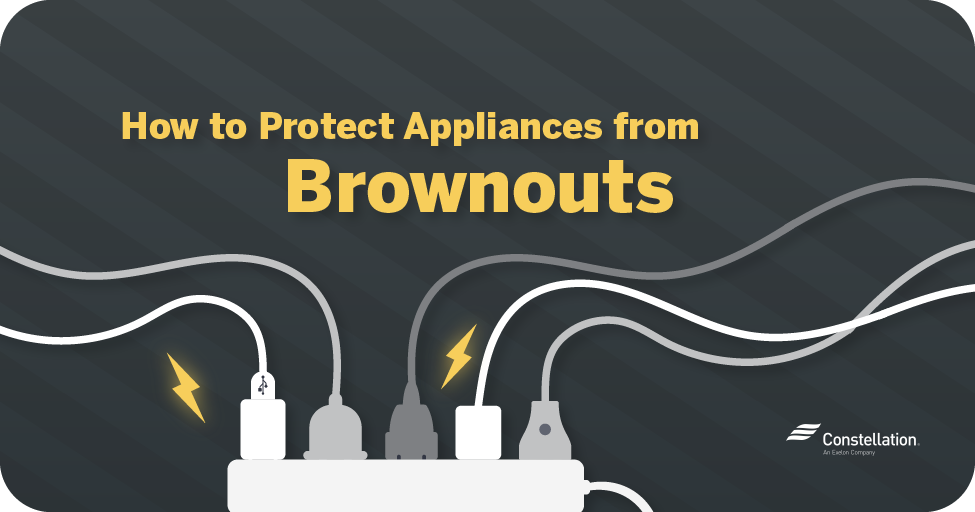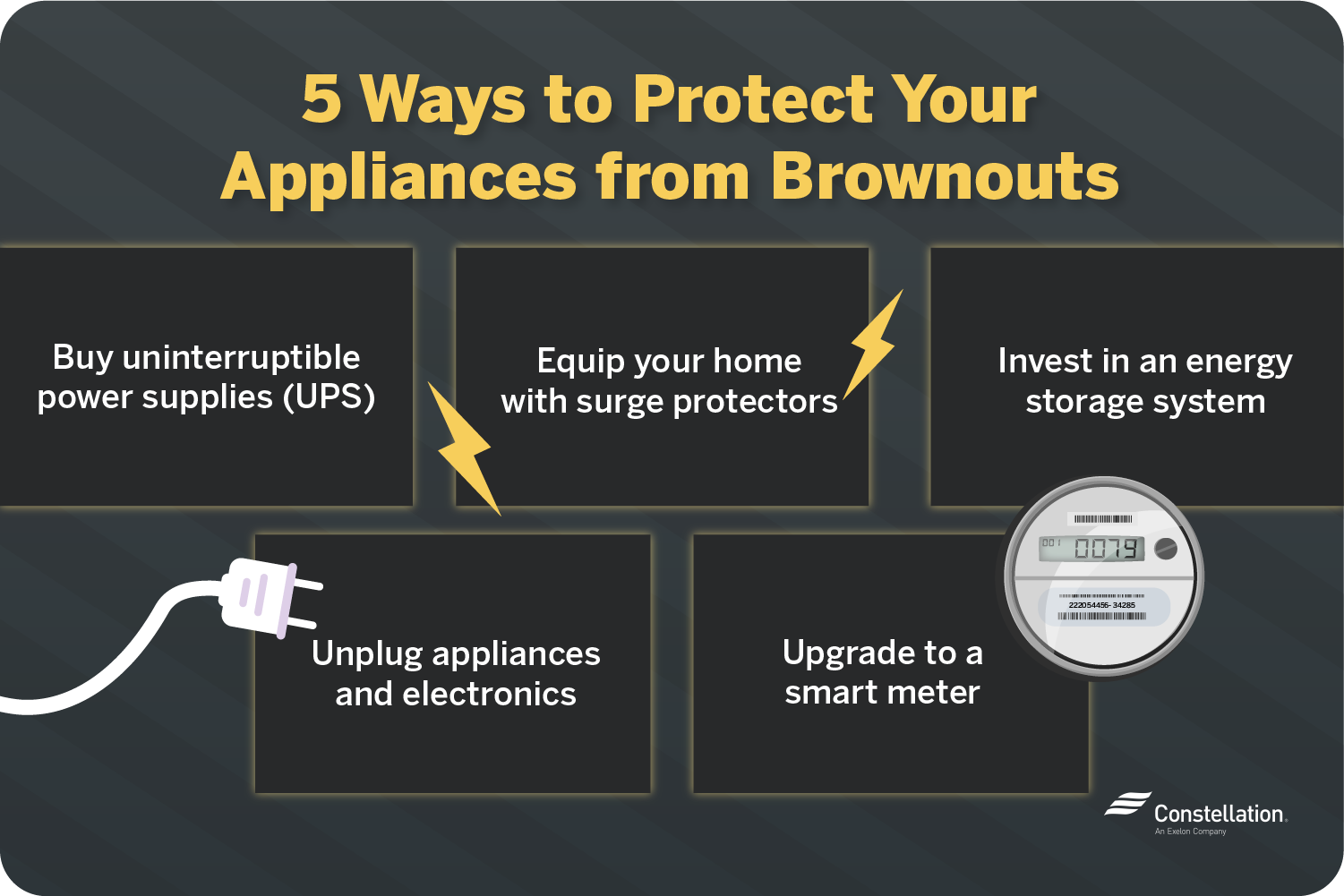
- Category:
Disaster Preparedness -
Last updated:
September 28, 2021
How to Protect Appliances from Brownouts & Other Power Supply Changes
Brownouts aren’t common; however, understanding brownout protection can be helpful to safeguard expensive devices. Keep reading for information about what causes brownouts and how to prevent brownout damage — with tips and resources to keep you prepared.
What is an electrical brownout?
When a power system experiences a voltage drop, either intentionally or unintentionally, it’s called a brownout. The difference between a brownout and a blackout is that when the latter happens, the entire system goes down. The term “brownout” came from the dimming of lighting that happens during a reduction in voltage.
As a general rule, make sure to report a power outage to your power company as soon as you can.
What causes brownouts?
Brownouts have two causes. One is from unexpected damage to part of the power system. The other is when the power company intentionally reduces voltage to reduce stress on the system and prevent damage that could lead to a full power outage. Common causes of power outages are:
- Increased demand for energy. On extremely hot days, air conditioners are working harder, which can place additional stress on the power grid. High demand is just one of the reasons behind what causes brownouts.
- Severe weather. Storms with high winds and lightning can damage power stations, high-voltage wires and even the local transformers and power lines on your street. In the winter, wind and ice can wreak havoc. Be ready for summer storms and also prepare for a winter power outage.
- Damage to the energy grid. Old equipment can fail. Cyberattacks can affect inadequately protected systems. Solar flares, though rare, are another possibility. All can cause reductions in voltage.
Can brownouts damage electronics?
Brownouts can damage electronics. Two kinds of devices are most vulnerable to brownout damage. Appliances with electric motors are at risk. As voltage declines, the motor draws more power, which can cause it to overheat. Components in sophisticated electronics are also easily damaged when underpowered. When full voltage is restored, they can blow in the resulting power spike. Brownout protection strategies can help you avoid these problems.
How to protect your appliances from brownouts
Brownouts do happen — but you don’t need to put your expensive appliances and electronics at risk of brownout damage when they do. Always treat electricity with respect and follow electrical safety tips. Beyond that, here are options for how to protect appliances from brownouts:

1. Purchase uninterruptible power supplies (UPS)
You can prevent brownout damage by connecting critical devices and appliances to a device that delivers emergency power when voltage is low. It clicks on nearly instantaneously and runs long enough for you to power devices down or switch them to generator power. Buying a few minutes of time can save you from costly damage, making a UPS a handy brownout protection device.
To keep devices running during a long-term power outage, you need extended power. You can investigate your options in our generator buying guide.
2. Equip your home with surge protectors
Do surge protectors protect against brownouts? Only partially. Although they won’t help when the voltage draws down in a brownout, they do protect against power surges when a brownout ends.
Inexpensive surge protectors provide some protection; however, many people don’t use them for every appliance. Few people will put a 240V stove, washer or dryer on a strip. A whole-home surge protection device will protect all devices in your home.
3. Invest in an energy storage system
These consumer-friendly devices combine a powerful battery with an inverter and give you a variety of sockets, from USB to 12V to AC jacks to use. You can connect these energy storage systems into your home electrical system. Gas-powered generators can also be integrated. Either way, these systems kick in when the grid goes down to keep your appliances operating safely.
4. Unplug certain appliances and electronics before power is restored
Here’s an easy brownout prevention strategy that’s low-tech and cost-free. When power goes out, unplug appliances such as televisions, computers and other expensive devices. A power surge can’t affect devices that aren’t connected to power.
Power can be unstable immediately after a brownout. Wait 10 minutes or so before plugging devices back in. If you can wait longer, it’s even better.
5. Upgrade to a smart meter
Smart meters help the power company prevent brownouts. They do more than just give you detailed data about your own power usage. These smart devices allow the power company to see the whole system, identifying power problems at your house or on your street so they can respond quicker.
Which appliances and electronics are most vulnerable to power failures?
Some companies are integrating surge protection into devices. But for the most part, it’s up to you to protect your investment. Here are some home devices that may be left vulnerable in the event of a brownout:
- Televisons. TVs today are pretty high-tech. Unplug them and any devices that connect to them.
- Game consoles, cable boxes and streaming devices. Some of these devices are as power-hungry as they are delicate.
- Computers. Sensitive electronics inside today’s computers are susceptible to power surge damage.
- Printers and peripherals. These devices are just as sensitive as computers, so protect them from surges, too.
- Refrigerators. In a low-voltage situation, the compressor motor can burn out and can also be damaged when the power surges back on.
- Washing machines & dryers. In addition to the motors that can be damaged in low-voltage situations, many of these devices are loaded with sensitive electronics that are also vulnerable.
- Microwave ovens. The diodes inside these appliances are easily destroyed in a power surge.
- Air conditioners. A/C units use lots of power and can be damaged in power surges and sags.
- Mobile devices and any smart home Internet of Things devices. Computers and connectivity are everywhere. Protect these expensive and delicate devices from power fluctuations and surges.
Take steps to prevent brownout damage
With good preparation strategies and tools to prevent brownout damage, you could possibly eliminate costly repairs and having to replace appliances. A little care can turn a potential emergency into a mere inconvenience. Power disruptions are rare, but given how much you have invested in your appliances and electronics, it’s best to do what you can to ease any disruption and prevent any problems.




